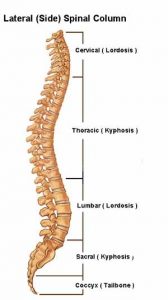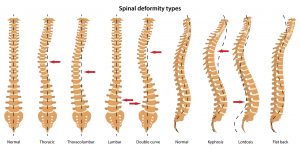Your Posture and the Shape of your Spine
Posted by Phil Heler on January 18, 2016Poor posture through slouching and carrying frequent heavy loads can cause supporting muscles and ligaments to stretch in the spine.
The normal spine has an S-shaped curve when viewed from the side. This shape allows for an even distribution of weight and flexibility of movement, and is supported by good posture.
The spine curves in the following ways:
– The neck (or cervical spine) curves slightly inward and this is what we call a lordotic curve.
– Your mid-back, or thoracic spine, curves outward, forming a regular C-shape and we call this a kyphotic curve.
– The lumbar spine curves inward and, like the cervical spine, has a lordotic curve.
These curvatures help balance our spine and resist the forces of gravity against the weight of our own bodies. However, the curves of the spine can be exaggerated in any plane, leading to pain, deformity and sometimes neurologic dysfunction. Some abnormal curves are asymptomatic while others require treatment.
Kyphosis is the correct term for the curvature of the spine in the middle of the back (or thoracic spine). A small degree of curvature is perfectly natural as seen in the diagram above. However, a curve of more than 45 degrees is considered excessive.
Sometimes it may be totally asymptomatic but in some cases pain and stiffness can be evident as the body struggles to cope and compensate. There can be several reasons why this occurs:
- Poor posture through slouching and carrying frequent heavy loads can cause supporting muscles and ligaments to stretch in the spine
- Abnormal vertebral development (Scheuermann’s)
- Spinal injury
- Osteoporosis, hence the term Dowager’s Hump (sometimes seen in older women)
Lordosis is the term for inward curving of the spine that occurs naturally in the lower back and the neck. A small degree of both kyphotic and lordotic curvature is the ideal and indeed this is how things should be.
However, too much curving in the lower back is called ‘swayback’ (or lordosis) and these people will often have a visible arch in their lower backs. The easiest way to check for lordosis is to lie on your back on a hard surface. You should be able to slide your hand under your lower back, with little space to spare. If you have a lordosis, you will have extra space between your hand and your lower back.
Causes of lordosis include:
- Poor posture
- Obesity
- Osteoporosis (weakening of the bones with age)
- kyphosis (an excessive outward curvature at the mid-back)
- spondylolisthesis (a condition in which one vertebra slips forward or backward relative to the next vertebra).
Scoliosis
Another issue with the spine is a sideways curve. Scoliosis is when you have a sideways curvature in your spine at an angle of more than 10 degrees that doesn’t go away when you bend. Scoliosis mainly affects children but there is also an incidence rate in adults. It can develop at any age but is most common in children aged 10-15. In the UK, around three or four in every 1,000 children require treatment for scoliosis.
Treatment for scoliosis depends on your age, how severe it is, and whether it is thought that it will worsen with time. In very young children, treatment is not always necessary because the curvature of the spine may improve naturally as they get older.
If treatment is necessary, bracing or casting may be used to attempt to halt the curve’s progression or alternatively ensuing surgery may be necessary.


